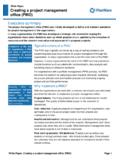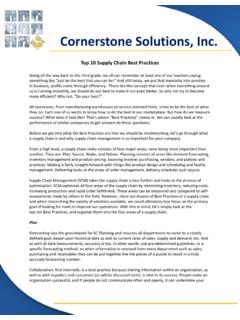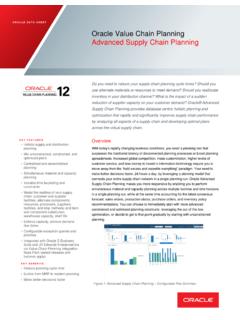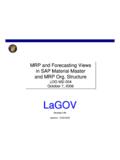Transcription of Use of Statistical Forecasting Methods to Improve …
1 Use of Statistical Forecasting Methods to Improve demand planning Marcel Baumgartner Talk given at the Swiss Days of Statistics 2004 Nestec Aarau, November 18th, 2004 1800 Vevey What is a Supply Chain ? In an more and more global and speedy economy, Supply Chain Management (SCM) is becoming a key competitive advantage for many businesses. A typical Supply Chain looks as below: Procurement demand & Sales &. Suppliers Supply Marketing Distributor Consumer planning Flow of Information Flow of Goods Manufacturing Distribution Goal of Supply Chain Management The goal of Supply Chain Management is to optimize of the Total Supply Chain. One strives for an optimum balance between costs, service and time to react to market opportunities. Cost elements: inventory, distribution, raw material, bad goods, .. Service elements: Our products need to be available wherever, however, whenever And in top quality !
2 Reaction: The food area is heavily driven by promotional activities. The supply chain needs therefore be able to react quickly to opportunities. demand planning (Sales Forecasting ). demand planning (DP) is one key element of the Supply Chain. Its objective is to ensure that the best possible estimate of true customer demand is released on a weekly (or if necessary daily) basis to drive supply, sales and financial planning processes. A demand Plan might look like this: Location Unit .. Nescaf Gold 20x500G DC1 CRT 1000 1500 2000 1000 1000 1500 500 500 .. " DC2 CRT 750 750 750 750 750 750 750 750 .. demand Plans demand Plans are done for at least the next 12 months. They are refreshed regularly, normally once every week. Why do we need such a detailed information ? We work in a make-to-stock environment. That is we cannot wait for the orders of our clients to produce.
3 We also need to plan the production of the products often well in advance. Particularly, if the products are imported. The plants also need to know how much capacity will be used in the future. Maybe, they need to hire more people. But how many ? Another rationale for accurate demand plans is the purchasing of raw and packaging material. Some raw material is bought only once or twice a year. demand Plans The number of products is often huge: the same chocolate is sold with many different packages. Also, the products are changing all the time: new products are launched, old ones eliminated, .. And some businesses, like Ice Cream, have a very regionalized and thus complicated distribution network. There is thus a clear need that this process is to some degree automated. demand Planners should be able to work by exception.
4 Players in demand planning Many employees in a business play a role in demand planning : Sales People: They are in close contact with the distributor ( supermarket chains). They make the deals (promotions). They assure that our products obtain the correct shelf space (and this does cost money !). Marketing People: They drive the products, the brand. Through adversiting and events. They are also those that change the products (renovation), and create new ones (innovation). This is more and more done together with the research departement. Financial People: They want to see whether the plans allow to meet the financial objectives for the current year. The Role of the demand Planner This is the person that makes sure that the contributions of all the other players are taken into account. He or she drives the meetings and the discussions to obtain a consensus demand plan that is then released for production.
5 How do we obtain the demand Plans ? Through a mix of Manual inputs (Judgmental Forecasting ). Automatic inputs from Statistical Methods Split of the demand Plan Our approach: Split the final demand plan into two components: Base demand Incremental demand (positive or negative) due to planned activities Negative incremental demand is referred to as Cannibalization. Example: if you sell the 500g pack with a 20% price discount, the sales of the 250g pack will go down. Typically, base demand can be estimated through Statistical Methods . Once this base demand is available, sales and marketing people need to estimate what additional volume their activities will add. This is typically based on personal judgements, their experience and learnings document in so-called "learning logs". A typical learning could be: "if I promote the standard pack via a 2-for-1 promotion, I observed a sales increase of roughly 15%".
6 Statistical Forecasting of the Base demand Statistical Forecasting Methods are either univariate or multi-variate. Univariate Methods only use one single historical time series as input. For example the historical dispatches, or better, the historical orders of the clients. Multivariate Methods can use other types of quantitative and qualitative information, like economic indicators, temperatures, price changes, etc. They are most often based on variants of Multiple Linear Regression. Concerning univariate Methods : We have now some good experience using Exponential Smoothing type Methods , as well as Seasonal Linear Regression. We have no experience using ARIMA type models, but our situation, where, every week or month, many hundreds of time series need to be forecasted, does not call for more sophisticated Methods .
7 An Example with Multivariate Methods We have only limited experience with multivariate Methods . But a subsidiary of Nestl in the USA uses a model with roughly 75 input variables (a 5 year history in weeks). These variables are the dispatch history (in tons), seasonal effects (using dummy variables for the 12 months), acquisitions, mergers of clients, effects of public holidays, .. By creating this huge explanatory variables matrix, they annotate the history of the dispatches. They build then for each combination of product and dispatch location a multiple linear regression, through a classic stepwise backward variable selection procedure (using SAS). A dedicated team of roughly 5 statisticians is responsible for the forecast and for the maintenance of the models. Their model are continously diagnosed and refined. It took them several years to obtain the high degree of forecast accuracy they have nowadays.
8 This is a very strongly centralized approach is not typical of Nestl . Also, our demand Planners do not have such strong Statistical competencies. The typical demand Planner at Nestl . A typical demand Planner in a Nestl market does not use Statistical Methods (at least not yet) to forecast demand . A worldwide project that harmonizes business practices throughout the world intends now however to use more and more Statistical approaches to forecast the base demand . The Methods used are univariate. They are based on Exponential Smoothing and Linear Regression. Our challenge now is to understand how these Methods can be applied in our context and to train the demand Planners, so that they can use these techniques appropriately. The system used is from SAP, the number one supplier of business software. We use the module APO (Advanced planning and Optimization) and its sub-module demand planning .
9 Available Statistical Methods in SAP APO. The key Statistical Forecasting Methods available in APO are: Single Exponential Smoothing (set between 0 and 1). Holt's Linear Method (set and ). Seasonal Exponential Smoothing, without trend (set and ). Holt-Winters' Method (set , and ). Seasonal Linear Regression (ad-hoc method that estimates seasonal coefficients, de-seasonalizes the time series, fits a linear trend, and adds the seasonal coefficients back to the forecast). Only multiplicative seasonality is available. Although some automatic model selection routines are available, we do not use them. Their quality is not sufficient. Therefore, demand Planners need to determine the method and the parameters themselves. After deciding on what level the forecasts are done (per product or per product x location, ..), each history is linked to a Statistical method.
10 Choosing the Appropriate Method To choose the appropriate method, demand Planners need to be aware of the different components in a time series: the overall level, a trend and a seasonality. Food products are very often seasonal: ice cream, but also things like "Sauce Hollandaise" which is linked to the aspargus season or all the chocolates for Christmas and Easter. We propose the following decision tree: Holt-Winters' Method YES Seasonal Linear Regression Trend ? S NO Seasonal, no Trend YE. Seasonal ? Holt's Method NO. YES Linear Regression Trend ? NO. Single Exponential Smoothing 0 20000 40000 60000 80000. Y0. 1. Y0 .M01. 1. Y0 .M02. 1. Y0 .M03. 1. Y0 .M04. 1. Y0 .M05. 1. Y0 .M06. 1. Y0 .M07. 1. Y0 .M08. 1. Y0 .M09. 1. Y0 .M10. 1. Y0 .M11. 1. Y0 .M12. 2. Y0 .M01. 2. Y0 .M02. 2. Y0 .M03. Y0 04. 2. Y0 .M05. 2. Y0.





